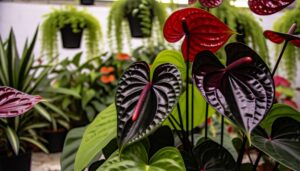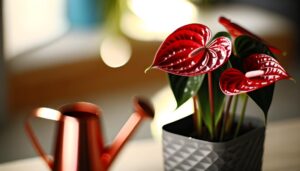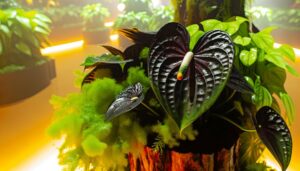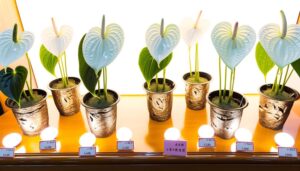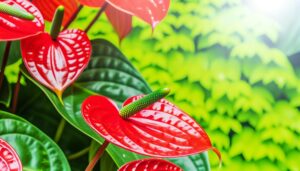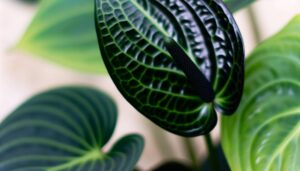Home Care for Anthurium Gracilis Red Pearls
To cultivate Anthurium gracilis 'Red Pearls' effectively, provide bright, indirect light and maintain temperatures between 65-75°F (18-24°C). Maintain consistent moisture using distilled or rainwater, and use a soil mix comprising orchid bark, perlite, and peat moss.
Sustain humidity levels at 70-80%, employing misting or humidifiers. Fertilize bi-weekly during growth periods with a balanced liquid fertilizer.
Regularly inspect for pests like spider mites and aphids, and utilize natural control methods. Repot every 2-3 years, using well-draining soil with a pH of 5.5-6.5.
To optimize root health, practice careful root handling and disease prevention strategies. For thorough guidance, further information is available.
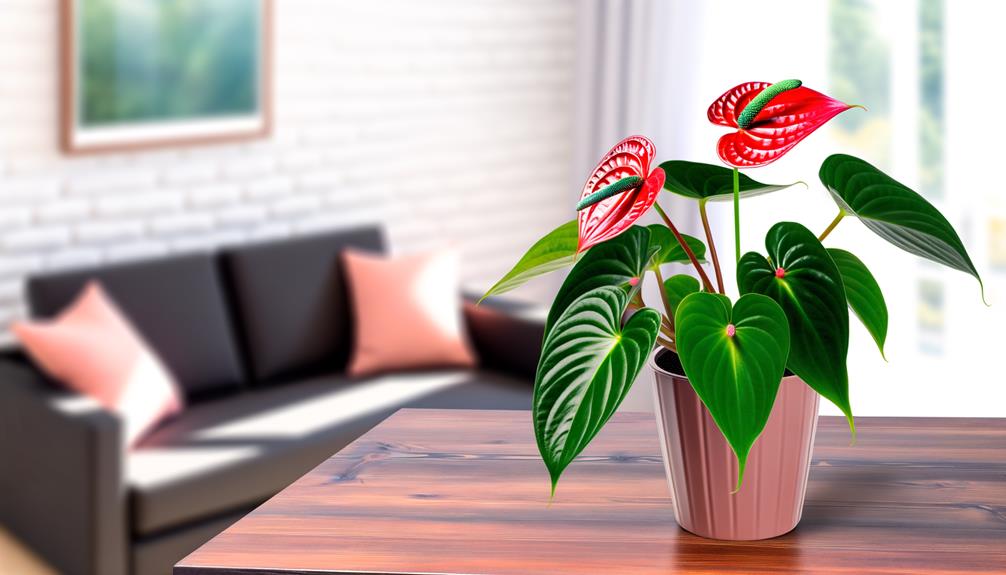
Key Takeaways
- Place Anthurium gracilis 'Red Pearls' in bright, indirect light and avoid direct sunlight.
- Keep the soil consistently moist and use distilled or rainwater to prevent mineral build-up.
- Maintain high humidity levels of 70-80% using humidifiers or misting regularly.
- Fertilize bi-weekly with balanced liquid fertilizer during the growing season.
- Repot every 2-3 years using a well-draining mix of orchid bark, perlite, and peat moss.
Light Requirements
Anthurium gracilis 'Red Pearls' requires consistent exposure to bright, indirect light to thrive at its peak performance. Best light conditions resemble its natural understory habitat in tropical rainforests. Direct sunlight should be avoided as it can cause photodamage to the delicate foliage, leading to chlorosis or leaf scorch.
A location with filtered sunlight, such as near an east or north-facing window, is ideal. For artificial lighting, use fluorescent or LED grow lights that emit a full spectrum to replicate natural sunlight. Maintain a photoperiod of approximately 12-14 hours daily. Insufficient light levels can result in etiolation, characterized by elongated stems and pale leaves.
Regularly monitor light intensity using a lux meter to optimize it within the 10,000-20,000 lux range.
Watering Schedule
Proper hydration is crucial for the health of Anthurium gracilis 'Red Pearls', requiring a watering schedule that maintains consistently moist, but not waterlogged, soil conditions. Best watering involves using distilled or rainwater to avoid mineral build-up. Water the plant when the top inch of soil feels dry to the touch. Ensure adequate drainage to prevent root rot, as standing water will harm the plant's root system. Utilize a humidity tray or mist the leaves regularly to replicate its native humid environment.
| Frequency | Watering Method |
|---|---|
| Spring & Summer | Weekly |
| Fall & Winter | Bi-weekly |
| Humidity Maintenance | Misting, Humidity Tray |
| Water Type | Distilled, Rainwater |
Implementing this schedule will support robust growth and vibrant foliage.
Ideal Temperature
Maintaining an ideal temperature range between 65-75°F (18-24°C) is important for the healthy growth of Anthurium gracilis 'Red Pearls'. This temperature range mimics the plant's natural tropical habitat, ensuring best physiological processes such as photosynthesis and nutrient uptake.
Deviations outside this range can stress the plant, potentially leading to issues like reduced growth or susceptibility to diseases. During colder months, it is essential to avoid temperatures below 60°F (15°C), as prolonged exposure can cause chilling injury.
Conversely, temperatures exceeding 80°F (27°C) may require increased ventilation and shading to prevent heat stress. Employing a digital thermometer to monitor environmental conditions can aid in maintaining the recommended temperature range, facilitating strong and vibrant foliage.
Humidity Needs
In tandem with maintaining ideal temperature, ensuring a high humidity level of 70-80% is essential for the thriving growth of Anthurium gracilis 'Red Pearls'. This tropical plant, native to humid rainforests, requires consistent moisture in the air to sustain its lush foliage.
To achieve best humidity, consider the following methods:
- Humidifiers: Utilize a room humidifier to maintain consistent humidity levels.
- Pebble Trays: Place the plant pot on a tray filled with water and pebbles, ensuring the pot base is above water level.
- Misting: Regularly mist the leaves with distilled water to mimic natural moisture conditions.
- Grouping Plants: Cluster multiple plants together to create a microenvironment with higher humidity.
Proper humidity management is optimal for Anthurium gracilis 'Red Pearls' health.
Soil Mix
Selecting the appropriate soil mix for Anthurium gracilis 'Red Pearls' is essential, requiring a well-draining medium composed of equal parts orchid bark, perlite, and peat moss to replicate the plant's natural epiphytic growing conditions. This combination guarantees adequate aeration and moisture retention, critical for the healthy growth of Anthurium gracilis.
| Component | Proportion | Function |
|---|---|---|
| Orchid Bark | 1/3 | Enhances drainage and aeration |
| Perlite | 1/3 | Improves soil structure and drainage |
| Peat Moss | 1/3 | Retains moisture and provides acidity |
Each constituent contributes uniquely: orchid bark prevents waterlogging, perlite maintains soil structure, and peat moss ensures consistent moisture. This meticulously balanced mix facilitates root health and mimics the plant's native environment, promoting robust growth and vibrant foliage.
Fertilization Tips
To support the vigorous growth of Anthurium gracilis 'Red Pearls', a balanced fertilization regimen is critical, utilizing a diluted, balanced liquid fertilizer (20-20-20) bi-weekly during the active growing season. Following this schedule is crucial for best nutrient uptake and health.
Follow these guidelines:
- Dilution Ratio: Mix the fertilizer at half the suggested strength to avoid root burn.
- Application Timing: Fertilize every two weeks from early spring through late summer.
- Watering: Ensure the soil is adequately moist before application to facilitate effective absorption.
- pH Monitoring: Maintain soil pH between 5.5 and 6.5 for optimal nutrient availability.
Pruning Guide
Proper pruning of Anthurium gracilis 'Red Pearls' requires meticulous attention to both tools and timing. Employ sterilized, sharp pruning shears to prevent pathogen transmission, and schedule pruning sessions during the plant's active growth phase in spring and early summer.
Focus on removing senescent foliage and spent inflorescences to promote healthy growth and enhance the plant's aesthetic appeal.
Tools and Preparation
An all-encompassing pruning guide for Anthurium gracilis 'Red Pearls' necessitates the use of sterilized cutting tools, such as bypass pruners or precision shears, to mitigate the risk of pathogen transmission. Proper tools and preparation are paramount to ensure optimal plant health and promote vigorous growth.
Follow these steps for effective pruning:
- Sterilization: Clean tools with isopropyl alcohol (70%) to eliminate any potential pathogens.
- Tool Selection: Use bypass pruners for larger stems and precision shears for finer cuts, ideal for Anthurium gracilis.
- Inspection: Examine the plant for diseased or dead foliage before starting.
- Cutting Technique: Make precise, angled cuts above a node to encourage new growth and reduce water retention issues.
These steps will facilitate a successful pruning process.
Seasonal Pruning Tips
Understanding the ideal times for pruning Anthurium gracilis 'Red Pearls' is crucial for maintaining its vibrant health and promoting robust growth throughout the year. Pruning should be strategically performed to enhance the plant's structural integrity and support optimal flowering. The table below outlines the seasonal pruning guidelines:
| Season | Pruning Tips |
|---|---|
| Spring | Remove any deceased or injured leaves to stimulate new growth. |
| Summer | Light trimming to maintain shape; avoid extensive pruning to prevent stress. |
| Fall | Trim back spindly stems and prepare plant for dormant period. |
Utilize sterilized pruning shears to prevent the spread of pathogens. Make sure each cut is made just above a leaf node to encourage fuller growth. Regular pruning not only enhances visual appeal but also helps reduce the risk of pest infestations and disease.
Common Pests
Anthurium Gracilis Red Pearls are susceptible to several common pests, including aphids (Aphidoidea), spider mites (Tetranychidae), and mealybugs (Pseudococcidae).
Accurate identification of these infestations is critical for effective management. Employing natural pest control methods, such as introducing beneficial insects like ladybugs (Coccinellidae) and maintaining ideal humidity levels, can mitigate these pest issues.
Preventive measures, including regular inspection and isolation of new plants, are vital for long-term health.
Identifying Common Infestations
Several common pests can infest Anthurium gracilis 'Red Pearls,' including spider mites (Tetranychus urticae), mealybugs (Pseudococcidae), aphids (Aphidoidea), and thrips. Identifying these infestations early is critical for effective management.
Below are key indicators for each pest:
- Spider Mites (Tetranychus urticae): Look for fine webbing on the underside of leaves and stippling or yellowing of leaf surfaces.
- Mealybugs (Pseudococcidae): Identify the presence of cotton-like masses on stems and leaf nodes, often accompanied by honeydew and sooty mold.
- Aphids (Aphidoidea): Notice clusters of small, soft-bodied insects on new growth, which may lead to leaf curling and stunted growth.
- Thrips: Detect silvering of leaf surfaces, distorted flowers, and black specks of frass.
Understanding these signs can help maintain the health of your Anthurium.
Natural Pest Control
Effectively managing common pests in Anthurium gracilis 'Red Pearls' through natural methods requires a thorough understanding of biological control agents and their application. For instance, *Phytoseiulus persimilis* is an efficient predatory mite against *Tetranychus urticae* (spider mites). Introduce them to the infested plant, ensuring ideal humidity and temperature to facilitate their activity.
*Cryptolaemus montrouzieri*, commonly known as the mealybug destroyer, targets *Pseudococcidae* infestations. Apply these beetles directly to affected areas. Additionally, *Encarsia formosa* is a parasitic wasp effective against *Trialeurodes vaporariorum* (whiteflies). Release them near the lower leaf surfaces where whiteflies congregate.
Regular monitoring and timely introduction of these biological agents can notably reduce pest populations without chemical interventions.
Preventive Measures Tips
Implementing preventive measures against common pests in *Anthurium gracilis* 'Red Pearls' involves maintaining ideal environmental conditions, such as sufficient humidity levels and proper air circulation, to deter pest colonization. Make sure to follow these steps:
- Humidity Control: Maintain relative humidity between 60-80% to prevent spider mites (*Tetranychus urticae*) and aphids (*Aphidoidea*).
- Air Circulation: Use fans to provide gentle airflow, reducing the likelihood of fungal gnats (*Sciaridae*) and mealybugs (*Pseudococcidae*).
- Regular Inspection: Perform weekly checks for early signs of infestation, focusing on the undersides of leaves and stems.
- Sanitation: Remove fallen debris and dead leaves promptly to eliminate breeding grounds for pests.
These practices guarantee a healthy environment for *Anthurium gracilis* 'Red Pearls', minimizing pest risks effectively.
Disease Prevention
To prevent diseases in Anthurium Gracilis Red Pearls, it is vital to maintain ideal growing conditions. This involves ensuring proper air circulation, humidity control, and regular sanitation practices. Effective air circulation can be achieved by spacing plants adequately and using oscillating fans.
Maintain relative humidity between 60-80% to mimic the plant's native tropical habitat, employing humidifiers if necessary. Regularly inspect leaves for signs of pathogens such as Xanthomonas or Pythium, and promptly remove any affected foliage. Sterilize tools with a 10% bleach solution to prevent pathogen transmission.
Utilize well-draining, sterile potting media to prevent root rot. Applying a fungicide like copper-based compounds can provide additional protection. Consistent monitoring and immediate action are essential for maintaining plant health.
Repotting Instructions
Repotting Anthurium gracilis 'Red Pearls' requires careful consideration of pot size to prevent root congestion and guarantee ideal growth.
Choosing a suitable soil mix, like a combination of orchid bark, peat, and perlite, is essential for maintaining the correct moisture and aeration levels.
When handling the roots, it is important to minimize damage to the delicate root system, thereby facilitating a successful shift to the new pot.
Choosing Pot Size
Choosing the right pot size for Anthurium Gracilis Red Pearls is important to promote optimal root growth and plant health. Proper potting is essential to avoid root-bound conditions and to provide sufficient aeration. Follow these steps:
- Initial Pot Size: Begin with a pot that is 1-2 inches larger in diameter than the root ball of your Anthurium Gracilis Red Pearls.
- Material: Select a pot made of terracotta or plastic with ample drainage holes to prevent waterlogging.
- Repotting Frequency: Repot every 2-3 years, or when roots begin to circle the pot, indicating limited root space.
- Increased Size: Gradually increase pot size by 2-3 inches with each repotting to accommodate root growth without overwhelming the plant.
Correct pot size directly influences the importance and longevity of Anthurium Gracilis Red Pearls.
Soil Mix Selection
Selecting the ideal soil mix for Anthurium Gracilis Red Pearls is crucial to guarantee proper drainage, aeration, and nutrient availability. A well-balanced mix should include components like orchid bark (to improve drainage), sphagnum moss (for moisture retention), and perlite (to enhance aeration).
A recommended ratio would be 40% orchid bark, 30% sphagnum moss, and 30% perlite. Incorporating a small amount of charcoal can further assist in maintaining soil purity. Ensure the pH level remains slightly acidic to neutral, ideally between 5.5 and 6.5.
Prior to repotting, sterilize the soil mix to eliminate potential pathogens. This tailored soil composition supports the epiphytic nature of Anthurium Gracilis, promoting healthy root growth and overall plant well-being.
Root Handling Tips
To minimize stress and peak health during the repotting process, gently loosen the root ball of Anthurium Gracilis Red Pearls, taking care to untangle any compacted roots without causing damage.
Follow these steps to promote successful repotting:
- Remove Plant from Pot: Carefully lift the plant from its current pot, supporting the base of the stems to prevent breakage.
- Inspect Roots: Examine the root system for signs of rot or disease, trimming any affected areas with sterilized pruning shears.
- Prepare New Pot: Select a pot that is 2-3 inches larger in diameter, ensuring it has ample drainage holes.
- Plant Positioning: Place the Anthurium in the new pot, filling around the roots with a well-draining, aerated soil mix.
These steps will encourage healthy growth and thriving foliage.
Seasonal Care
Regularly adjusting care routines for Anthurium gracilis 'Red Pearls' according to seasonal changes is essential for maintaining ideal growth and health.
During the growing season (spring and summer), make sure that Anthurium gracilis receives bright, indirect light and maintains a humidity level of 60-80%. Watering should be consistent, ensuring the soil remains moist but not waterlogged. Fertilize bi-weekly with a balanced, water-soluble fertilizer at half strength.
In fall and winter, reduce watering frequency to allow the soil to dry slightly between waterings. Suspend fertilization and maintain a cooler environment, ideally between 15-20°C.
Monitor for signs of stress, such as yellowing leaves, and adjust care accordingly. These seasonal adjustments are crucial for the plant's optimal physiological functioning.
Conclusion
To sum up, the care of Anthurium gracilis 'Red Pearls' requires careful attention to light, water, temperature, humidity, and soil conditions.
A convincing statistic emphasizes the plant's inclination for high humidity levels, ideally between 70-80%, to replicate its native tropical environment.
Adequate handling of these factors, along with diligent observation for pests and diseases, promotes ideal growth and health.
Repotting should be done every two years to support root growth and maintain nutrient availability.

